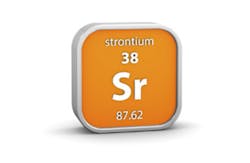Coming soon in the December issue of Water Technology, Technical Editor Dr. Joseph Cotruvo writes about strontium. In this Contaminant of the Month feature, Cotruvo begins by offering a little background on strontium.
“Strontium is a silvery alkaline earth metal like calcium and magnesium, but it oxidizes and burns in air,” explains Cotruvo. “It forms water soluble Sr++ salts, such as strontium chloride (SrCl2) and strontium carbonate (SrCO3), by losing two electrons.”
Cotruvo adds that strontium, with an atomic number of 38, has four stable natural isotopes and 12 mostly short-lived radioactive isotopes.
Strontium makes up around 0.02 percent of the Earth’s crust; however its salts can be traced in essentially all drinking water supplies. In the 1988 National Inorganics Reconnaissance Survey (NIRS), strontium was found in over 99 percent of 989 groundwater sources used for drinking water.
“Concentrations ranged from 1 ppb to > 10 ppm with a mean of 0.6 ppm (600 ppb),” states Cotruvo. “Preliminary results from the current unregulated Contaminant Monitoring Rule (UCMR 3) had 100 percent detections, including surface and groundwaters, with 95th percentile at 1.7 ppm (1,700 ppb).”
Treating strontium
Water softening can be effective at treating strontium. For point-of-entry (POE), softening with a cation exchange resin is common. For point-of-use (POU), reverse osmosis is a household treatment option.
“Precipitative lime softening with calcium hydroxide and lime-soda ash softening are used by municipal water plants,” adds Cotruvo.
The health effects of strontium
Although not highly toxic, there are concerns over excess exposure in early bone formation. “Strontium chemistry is similar to calcium’s chemistry, so it accumulates in bone and can affect bone formation at sufficient doses,” says Cotruvo.
Strontium replaces calcium in bones, affecting skeletal development. Although strontium can affect all life stages, infants, children and adolescents are of particular concern as their bones are developing, according to news from EPA covered in WaterTech e-News Daily.
The EPA Lifetime Drinking Water Health Advisory and the health reference level (HRL) were both 4,000 ppb (4 ppm); however as of October 2014, the HRL was changed to 1,500 ppb after EPA’s announcement of a preliminary determination to regulate strontium in drinking water.
“Seven percent of NIRS groundwaters exceeded 1,500 ppb and 14.3 percent exceeded half of the HRL,” informs Cotruvo. “If borne out, the regulatory impact would be significant. Monitoring requirements would affect all public water systems, and any health benefits would most likely be small.”
To learn more about strontium in drinking water, be sure to check out Water Technology’s December issue.
You can find similar articles and news releases pertaining to drinking water here.


